
Historical Places in Mahabubnagar District
Mahabubnagar is very close to the state Capital and located at 96 Kms from Hyderabad, is well connected by road and rail and Air with all important towns and cities in the State.
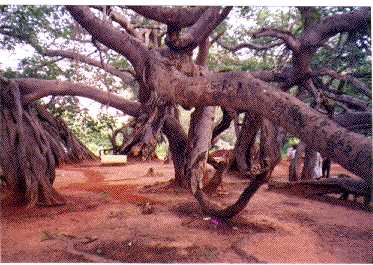
Pillalamarri : The most important place of interest near Mahabubnagar is the famous banyan tree called Pillalamarri, which is about 8-km from the city. The famous 500 yr. old Banyan tree here, covering an area of over three acres, can accommodate about 1000 people in its shade. There is a shrine of a Muslim saint under the tree. From a distance the tree presents the appearance of a small hillock with green foliage but on reaching nearer, it looks like a large green umbrella under which about thousand people can easily take shelter. The tree is a very old one and it covers an area of 3 acres (1.21 hectares).
People gather here for picnics and celebrations. You can know the history and Story of Pillalamarri by clicking here.
Temples And Mosques
Temples and Mosques in Mahabubnagar district are symbols of Palamoor's history. There are a number of temples
and some dates back to 2nd century BC. There
are also about 14 well known mosques and 8 Dargahs, the important among them being those of
Bagamaru Saheb, Syed Abdul Khader Saheb, Majoot Mardan Ali Shah Saheb, Umar Ali
Shah and Baba Tajuddin.
Umamaheshwaram (Home of Parvathi and lord Siva):
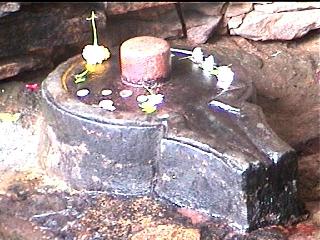
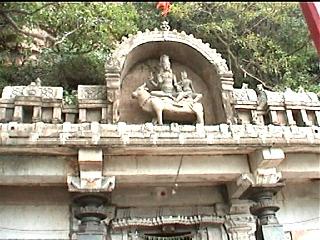
Umamahesshwaram is located at a distance of 150 KM from Hyderabad and close by Achampet in Mahabubnagar District. Umamaheshwaram temple is situated on very tall hills of Nallamala forests and dates back to 2nd century A.D. To reach the temple, one has to ride on very steep and dangerous curves of 5 mile length from the bottom of the hill. It is well known as North Entrance to Srisailam (Jyotirlingam). Umamaheshwaram temple is in deep Nallamala forests and located in vast range of Scenic mountains. This place is popular for it's Mysterious papanashanam where you can always find a mug of water, inspite with drawing any amount of water from it throughout the year. Nobody could figure out the source of water. Till today it is the home for innumerous Sadhus. The presiding deities in Umamaheshwaram are Mallikarjuna (Shiva) and Bhramaramba (Devi).
Alampur:
Location: 200 KM from Hyderabad, 90 KM from
Mahabubnagar and 27-km
From Kurnool
Previously Known As: Halampuram, Hamalapuram And Alampuram.
Architecture: Chalukyan sculpture
Also Known As: Navabrahmeshwara Theertha
Alampur is located in Mahabubnagar District and it is home to the very
ancient Navabhramma temples dating back to the 7th century CE.
Alampur is located at a distance of 200 km from Hyderabad. Alampur is considered
to be the western gateway of Sree
Sailam, the revered Jyotirlinga Shivastalam in Andhra Pradesh. The southern,
eastern, and northern gateways are Siddhavattam, Tripurantakam and
Umamaheswaram respectively.
The Tungabhadra and Krishna are in confluence near Alampur, which is also known as Dakshina Kailasam (as is Sree Kalahasti in Southern Andhra Pradesh). Nine temples here referred to as the Nava Bhramma temples are dedicated to Shiva.
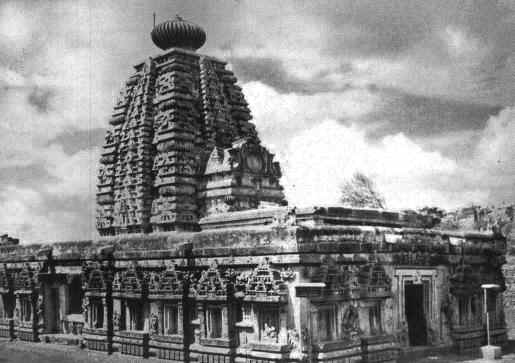
The Nava Bhramma temples were built by the Badami Chalukyas, who ruled for about 200 years from the middle of the sixth century onwards. The Badami Chalukyas built several temples in Karnataka, and the Alampur temples in Andhra Pradesh.The Alampur site preserves archeological remains in the form of temples exhibiting a hybrid style of architecture - dating back to the 6th-7th centuries CE. Some of the images from this site are also housed in a museum nearby.
The Nava Bhramma temples are Taraka Bhramma, Swarga Bhramma, Padma Bhramma, Bala Bhramma, Garuda Bhramma, Kumara Bhramma, Arka Bhramma, Vira Bhramma and the Vishwa Bhramma. These temples are all enclosed in a courtyard on the left bank of the river Tungabhadra.
The Bala Bhramma temple is the principal shrine of worship. It dates back to the year 702 CE - per the inscriptions seen here. Shivaratri is celebrated in great splendour here.
The Taraka Bhramma temple is partly in ruins, and it has no image in the sanctum. It bears telugu inscriptions from the 6th-7th century CE. The Swarga Bhramma temple with an imposing tower is considered to be among the finest in Alampur, and is an excellent specimen of Chalukyan architecture and sculpture. It contains several sculptures in bas relief, and it dates back to the end of the 8th century.
The Padma Bhramma temple partly in ruins, contains a Shivalingam of clear stone with mirror like finish. The Viswa Bhramma temple is among the most artistic of the Nava Bhramma temples. The sculptural work here depicts scenes from the epics.
Also in the enclosed courtyard is located the Suryanarayana temple, dating back to the 9th century. This temple has bas reliefs representing the incarnations of Vishnu. There is also a Narasimha temple with inscriptions from the period of Krishna Deva Raya of the Vijayanagar Empire.
Near Alampur, is Papanasam with a cluster of over 20 temples of varying sizes and styles. The most important of these is the Papanaseswara temple.
The following are the main temples to see in Alampur:
- Swarga Brahma temple Padma Brahma temple
- Garuda Brahma temple Bala Brahma temple Arka
- Brahma temple Kumara Brahma temple Vira
- Brahma temple Vishva Brahma temple Taraka
- Brahma temple
Plea
to save Alumpur temples (News)
7th Century Chalukyan Sculptures of Alampur
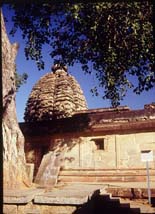
In the cultural history of South India, the emergence of the Chalukyas of Badami is an important event, particularly in the field of art and architecture. They caused the excavations of rock cut temples and construction of structural temples. Having made use of the locally available red sand stone, they experimented to blend the characteristic features of the contemporary Indian architectural styles--Rekhanaga and Dravida.
This dynasty controlled the whole of northern Deccan. The Chalukyas were supporters of Brahmanical Hinduism with its life and exuberant vitality. This resulted in their prolific building activities which evolved their special style of architecture.
Chalukyas architecture reflects from the following images, which still can be seen at Alampur.
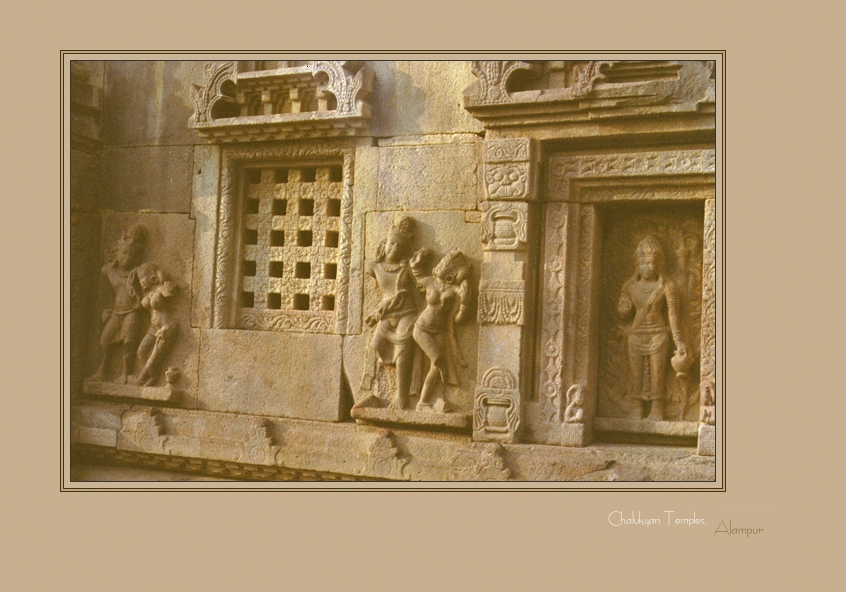
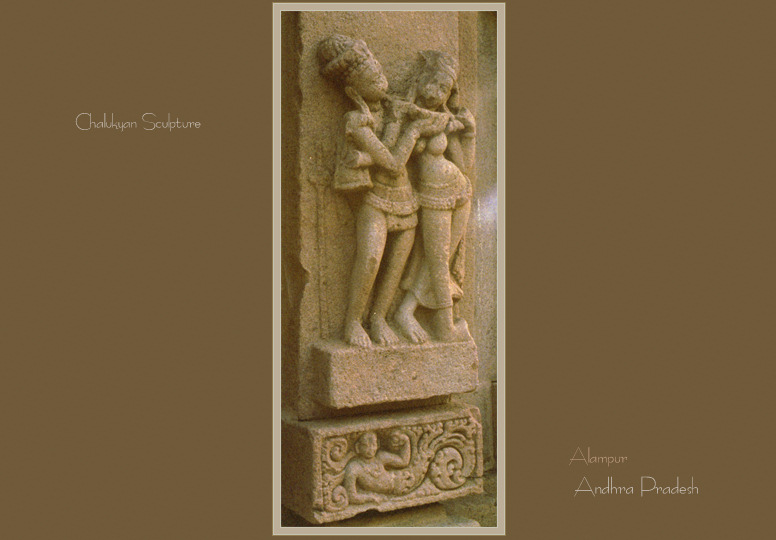
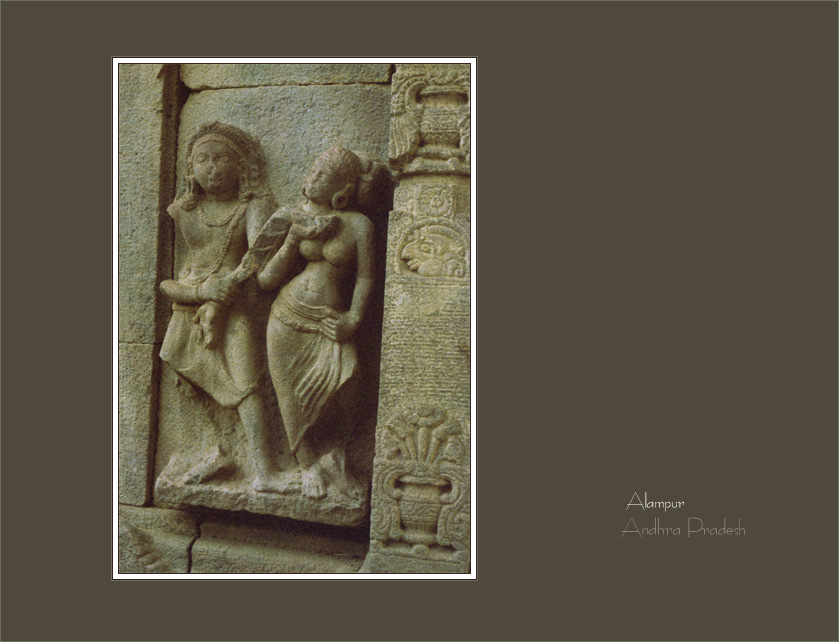
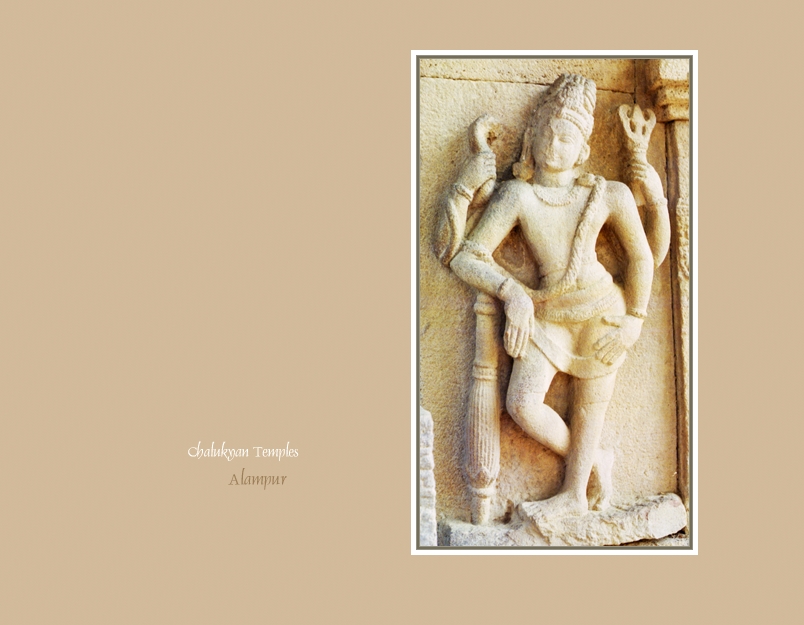
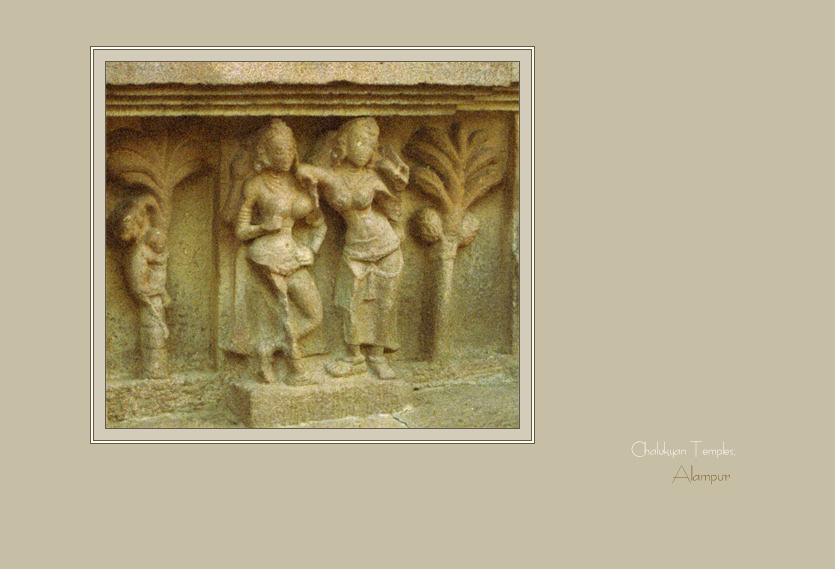
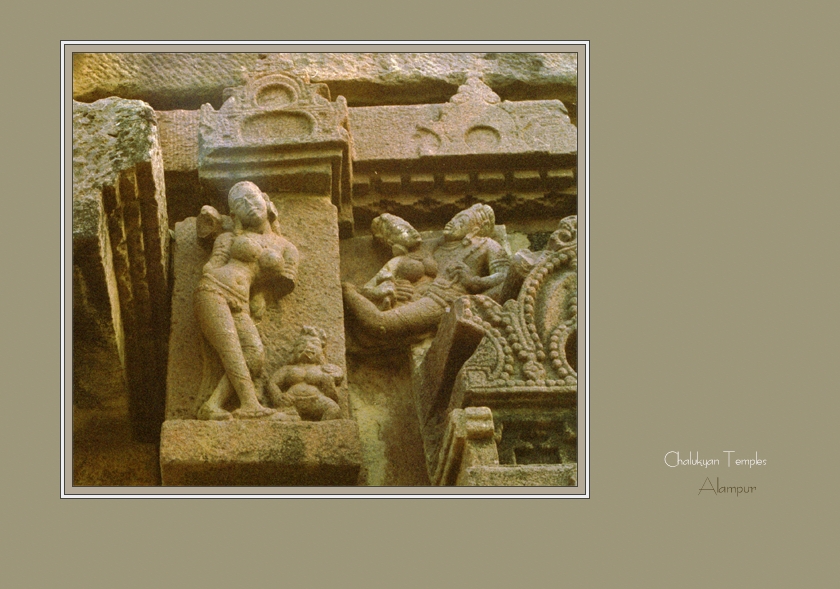
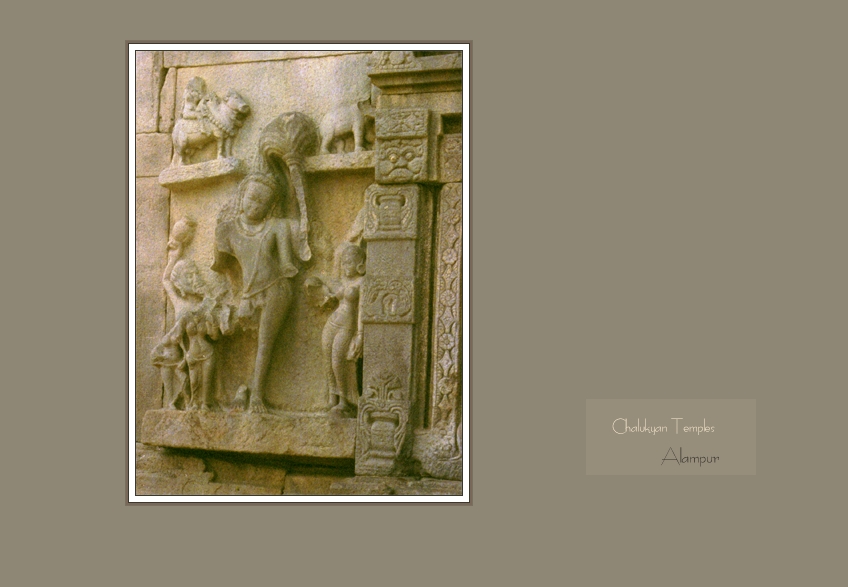

Other Historical Sites of Palamoor
Gadwal : Gadwal town , between the Krishna and Tungabadra Rivers, is noted for the harmonious coexistence here of the cultures A.P and Karnataka. Gadwal is also famous for its handloom weaving industry. Gadwal silk saris, with exquisite zari work command a good market through out the country.
Koilsagar Project : The Koilsagar Dam, about 8 km from koil konda village, stretches across the Peddavagu, a minor tributary of the Krishna River. The western stretch of this picturesque reservoir is surrounded by high hills, making it a beautiful spot.
Manikonda : The Lakshmi Venkateswara shrine is on a 915 Mts. high hill that is 2 km from the village.
Wanaparthi : The ancient shrine of Vittaleswara is located here. The Sarlasagar project nearby features the biggest syphon dam in the world.
Bala Nagamma (Aidamma): This famous ancient place has perched a coveted place in the temple history due to its association with the infinitely popular Balanagamma folk lore story popularised by the Burrakatha artistes akin to Harikatha bhagavathothamas. The goddess Aidamma played a spectacular role and established for herself a permanent place due to demonstration of her sports . She is popular as very compassionate goddess. Who rescues her aborers from the clutches of the Satanic forces. If they rely upon her and her bounty after offering soulful prayers. She reveals her dreadful aspect and is appeased with animal sacrifice most On account of enjoying her munificence and freed from the unending worries, she is adored passionately by rural folk and festivals are celebrated with great enthusiasm. Daily pujas, and the annual festival falling in the month of Sravana lure huge crowds, who are lustily participating in special prayer services to express their devotion to her. It lies in the Wanaparthi taluq of Palamoor district of Andhra Pradesh, accesible by bus.
Sri Ranganayaka Swamy,
Sri Rangapur
Once Krishnadevaraya went to Sri Rangam and wanted to construct Ranganayaka
Swamy temple in his kingdom. On that night he dreamt of ‘Ranganayaka
telling him that he is in a particular place in the kingdom and one eagle
will lead him to that place. Next day Krishnadevaraya followed the eagle and
found Ranganayaka Swami’s idol between Kothakota & Kanvayapally mountains.
Then the temple was built near "Ratna Pushkarini’ lake. From then poojas
are regularly performed and prasadam is distributed at 10 a.m. every day.
Srirangapur is situated at a distance of 12 kms. from Wanaparthy, which is 100
kms from Mahbubnagar. Srirangapur is well connected by road and there are
frequent buses from Wanaparthy. Private transport is available from Wanaparthy.
Beechupalli Anjaneya Swamy Temple
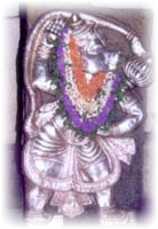 |
Beechupalli Anjaneya Swamy Temple lies in Mahboobnagar District in Alampur Mandal. It is in between Hyderabad-Kurnool route (NH 7), about one mile from Kondapeta. It is about 155km from Hyderabad. Rivers Krishna and Thungabadra merge at this place. The main deity is Lord Anjaneya. The main idol belongs to 16th century. |
Sangameswar Temple, Somasila
The temple is shifted from Sangameswar to Somashila to protect from being drowned in Krishna water. This place can be used as a leisure spot also. There are many Shivalingas in the temple complex. Shivarathri & Karthikamasam are celebrated with many fervors. For all festivals special poojas are held. Mainly pushakaras are celebrated in a grand style. Pushkara snanam is considered as most auspicious. Somasila is situated at a distance of 15 kms. from Kollapur which is 158 kms. from Mahbubnagar and 55 kms. from Kurnool. Somasila is well connected by road and there are frequent buses from Kollapur.
Worlds's largest Tiger Sanctuary (Mannanur): Dry deciduous mixed forest along the river Krishna which cuts through a picturesque gorge of the Nallamala hills with deep valleys on sides. The sanctuary with a wide area of 3568 Sq. km. spanning Guntur, Prakasam, Kurnool, Mahabubnagar and Nalgonda districts. About 130 km. south of Hyderabad. Animals found : Spotted Deer, Mouse Deer, Black Bucks, Sambhars, Chousingha Nilgai, Wild Boar, Indian Giant Squirrel, Tree Shrew, Rayel, Mugger Crocodiles, Wild dogs, Jackals, Wolves, Foxes, Sloth Bear, Panthers, Tigers. Accessibility: 130 km. by road from Hyderabad. Well connected with State owned buses. Contact: Field Director, Project Tiger, Achampet/Srisailam
Season: October to May.
Farahabad : Farahabad is at an altitude of 914 Mts. in the Nallamalla Hills in the Eastern Ghats. This holiday resort enjoys a salubrious climate. It has been most appropriately named Farahabad, which literally means 'Mount Pleasant'.
The Temple of Sri Kurumurthy Srinivas Swamy
This temple is on the hills of Kurupathi or Kurumurthy. It is self-manifested (Swayambhu). In confirmity of the legend once, Sri Laxmidevi earnestly desired Lord Srinivasa to make his Abode on the hills to enable his devotees to offer prayers. In Telugu "Kuru" means "to do" "Matim" means "mind" and "pati" means "husband". Hence, the hill is called Kurupati. About 630 years back the image of the Lord was in the cave. In 1350 A.D Sri Mukkara Chandra Reddy constructed the temple and later renovated by Sri Ramabhupal and Kotha Kapulu. As in the case of, Tirumala Tirupathi, Lord Srinivasa made his abode on the seven hills of Kurupathi. They are Swethadri, Ekadri, Durgadri, Ghanadri, Ballukadri, Patagadri and lastly Daivatadri. The Temple of Sri Kurumurthy Srinivasa Swamy is on the hills of Daivatadri. In the Temple History of Tirumala Tirupathi Devasthanam a detailed account has been given as how Brighu Maharshi kicked Sri Maha Vishnu on the right of his chest which forced Sri Laxmi Devi to desert her husband in protest and came down to the universe. In search of her Maha Vishnu also descended on earth and after several trails and turbulations, he became an idol and known as Lord Venkateswara.
Ê©x-«Õ©
ÂÌJh ÂËK-{¢Ð-«Õ-Cl-«Õ-œ¿Õ’¹Õ ‚¢•-¯ä§ŒÕ ‚©§ŒÕ¢
¯äšË ÊÕ¢* “X¾Åäu¹
…ÅŒq-„éÕ
ÆÍŒa¢-æX{, œË客-¦ª½Õ
16 (ÊÖu®ý-{Õœä): Ê©x-«Õ© ÂÌJh ÂËK-{¢’à „ç©Õ-’í¢-Ÿ¿Õ-ÅŒÕÊo
«ÕCl-«Õ-œ¿Õ’¹Õ “’ëբ-©ðE ¡X¾-¦sA ‚¢•-¯ä-§ŒÕ-²ÄyNÕ
‚©-§ŒÕ¢©ð ¨¯ç© 17 ÊÕ¢* 21 «ª½Â¹× ÆªáŸ¿Õ ªîV© ¤Ä{Õ
“X¾Åäu¹ …ÅŒq-„Ã©Õ Eª½y-£ÏÇ¢-Íä¢-Ÿ¿ÕÂ¹× \ªÃp{Õx
Íä¬Çª½Õ. XÏLæ®h X¾Lê Ÿçj«¢’à «ÕCl-«Õ-œ¿Õ’¹Õ ‚¢•-¯ä-§ŒÕ-²Äy-NÕE
‚ªÃ-Cµ-²Ähª½Õ. Ê©x-«Õ© Âí¢œ¿©ðx “X¾«-£ÏÇ¢Íä ¹%³Äg-ÊC
…ÅŒhª½ „ãÏÇ-E’à ¨ “¤Ä¢ÅŒ¢©ð “X¾«-£ÏÇ-®¾Õh¢C.
¨ ÊCÂË X¾œ¿-«Õª½ ÊÕ¢* Ÿ¿Õ¢Ÿ¿ÕGµ ÊC ¹Læ® Íî{ Ÿ¿Õ¢Ÿ¿Õ-¦µä-¬Áyª½¢
Ưä X¾ÛªÃº “X¾®ÏŸ¿l´„çÕiÊ ¬ëj«-êÂ~“ÅŒ¢ „ç©-®Ï¢C.
¨ êÂ~“ÅÃ-EÂË X¾œ¿-«Õª½ C¬ÁÊ 12 ÂË©ð-OÕ-{ª½x Ÿ¿Öª½¢©ð
«ÕCl-«Õ-œ¿Õ’¹Õ Ưä êª«Û X¾{dº¢ “ÂÌ®¾Õh ¬Á¹¢ «âœî
¬ÁÅÃGl Â颩ð „çL-®Ï¢C. ¨ “¤Ä¢ÅŒ¢©ð ƒÂ~Ãy-¹ש
Â颩ð ŠÂ¹ åXŸ¿l Âî{ÊÕ EJt¢-Íê½Õ. Âî{ ¯Ã©Õ’¹Õ
«â©-©¢Ÿ¿Õ ¯Ã©Õ’¹Õ ¦Õª½Õ-V©Õ,Ÿ¿ÂË~-ºÇÊ ŠÂ¹
¦Õª½ÕV, ¯çjª½ÕA C¬Á©ð ‡ÅŒh-ªáÊ “¤ÄÂê½¢, åXjÊ ªÃV
…¢œä E„î¾¢ EªÃt-º„çÕi …¢C. ƒC „î¾ÕhÂ¹× ÆÊÕ-’¹Õ-º¢’Ã
…¢Ÿ¿E Æ¢šÇª½Õ. Âî{©ð ²ÄyNÕ „ê½Õ ¨¬ÇÊu “¤Ä¢ÅŒ¢©ð
„çL®Ï X¾Û{d ÊÕ¢* ¦§ŒÕ-{Â¹× «*a-Ê{Õx …¯Ãoœ¿Õ. ÍŒÕ{Öd
¯Ã©Õ’¹Õ Æœ¿Õ-’¹Õ©Õ, ŠÂ¹ ’¹•¢ ‡ÅŒÕh ¹L-TÊ “¤ÄÂÃ-ª½X¾Û
’©Õ *Êo ‚©-§ŒÕ¢©ð „çL®Ï «ÕCl-«Õ-œ¿Õ’¹Õ êÂ~“ÅŒ
¤Ä©-¹×-E’à …¯Ãoœ¿Õ. ƒÂ~Ãy-¹ש Â颩ð N•-§ŒÕ-X¾ÛJ
ªÃVÂ¹× Šê ŠÂ¹ Æ«Ötªá ¹LT «Õ’¹ ®¾¢ÅÃÊ¢ ©ä¹-¤ò-«-{¢Åî
ŠÂ¹-¯ÃšË ªÃ“A ²ÄyNՄê½Õ ªÃV ®¾yX¾o¢©ð ª½Õ†Ï
ª½ÖX¾¢Åî «*a F Âî{©ð ¨¬ÇÊu C¬ÁÊ ‚¢èä-¯ä-§ŒÕ-²ÄyNÕ
X¾Û{d©ð ŸÄT …¯Ão-œ¿E Íç¤Äpœ¿Õ. ²ÄyNÕÂË ‡Ÿ¿Õ-ª½Õ’Ã
ŠÂ¹ Âî¯äª½Õ ÅŒNy¢* ŸÄE©ð «Õ¢œ¿©¢ ªîV©Õ ²ÄoÊ¢
Íä®Ï “¦£¾Çt «á£¾Þ-ª½h¢©ð ²ÄyNÕ „ÃJE ÆGµ-æ†-ÂË¢-ÍŒ-«ÕE
ÅçL-¤Äª½Õ. ‚ NŸµ¿¢’à Íäæ®h «Õ’¹ ®¾¢ÅÃÊ¢ ¹©Õ-’¹Õ-Ōբ-Ÿ¿E
æXªíˆ-¯Ãoœ¿Õ. ‚ NŸµ¿¢’à ÍçXÏp ª½Õ†Ï ÆŸ¿%-¬Áu-«Õ-§ŒÖuœ¿Õ.
ŸÄ¢Åî ‚ ªÃV Âî¯ä-ª½ÕÊÕ ÅŒNy¢* «Õª½Õ-®¾šË ªîV
ÊÕ¢* Âî{-©ðE ¨¬ÇÊu C¬Á©ð …Êo X¾Û{dÊÕ ÅŒ«y’à ƢŸ¿Õ©ð
²ÄyNÕ Â¹E-XÏ¢-ÍÃœ¿Õ. ‚ ªîV ÊÕ¢* ²ÄyNÕE ÆÊÕ-EÅŒu¢
¦µ¼ÂËh “¬ÁŸ¿l´-©Åî ‚ªÃ-Cµ¢-ÍÃœ¿Õ. Âí¢ÅŒ ÂéÇ-EÂË
‚ ªÃVÂ¹× Æªá-Ÿ¿Õ-’¹Õª½Õ ¹׫Ö-ª½Õ©Õ ¹L-’ê½Õ.
‚ NŸµ¿¢’à ¯ÃšË ÊÕ¢* ¯äšË-«-ª½Â¹× Ưä¹ «Õ¢C
¦µ¼Â¹×h©Õ ²ÄyNÕE æ®N¢* ®¾¢ÅÃÊ¢ ¤ñ¢Ÿ¿Õ-ÅŒÕ-¯Ão-ª½Êo
“X¾¬Á®Ïh …¢C. ²ÄyNÕ „ê½Õ ÅŒÊ «Õ£ÏÇ-«Õ-©Åî
¦µ¼Â¹×h© Âî骈©Õ Bª½Õ-²Äh-œ¿Êo Ê«Õt¹¢ …¢C. Âé-’¹-ª½s´¢©ð
Ưä¹ \@ÁÙx ’¹œ¿-*Ê ÅŒŸ¿Õ-X¾J «ÕCl-«Õ-œ¿Õ’¹Õ
êª«Û X¾{d-º¢’à ª½Ö¤ñ¢-C¢C. Ưä¹ «Öª½Õp©Õ Íç¢CÊ
X¾ÛºuêÂ~“ÅŒ¢’à “X¾®ÏCl´éÂÂˈ¢C. ªÃV©Õ, ªÃèÇu©Õ
X¾ÅŒ-Ê„çÕi ¤òªá¯Ã ¯ÃšË Æ«-¬ì-³Ä©Õ ¯äšËÂÌ «ÕCl-«Õ-œ¿Õ’¹Õ
X¾œ¿-«Õª½ ¦µÇ’ÃÊ ¯Ã©Õ’¹Õ ÂË©ð-OÕ-{ª½x ¤ñœ¿-«ÛÊ
¤ÄÅŒªÃA ¹{d-œÄ©Õ ¹E-XÏ-®¾Õh-¯Ãoªá. ²ÄyNÕ „ÃJ «â©
NªÃ{Õd N“’¹£¾Ç¢ «âœî ¬ÁÅÃGl Âé¢ ¯ÃšË-Ÿ¿E ÍÃJ-“Ō¹
X¾J-¬ðŸµ¿Â¹×©Õ ÆGµ-“¤Ä-§ŒÕ-X¾-œ¿Õ-ÅŒÕ-¯Ãoª½Õ.
Ê©x-«Õ© Æ{O “¤Ä¢ÅŒ¢©ð …¢œä Íç¢ÍŒÕ©Õ X¾¢œ¿Õx,
¤Ä©Õ, Åä¯ç ¯çj„ä-Ÿ¿u¢’à ®¾«Õ-Jp¢-ÍŒÕ-ÂíE “X¾A ªîV
²ÄyNÕE X¾Ü>¢Íä „Ãª½Õ. Æœ¿-«Û©ðx ®¾¢ÍŒ-J¢Íä X¾¬ÁÙ-«Û©
ÂÃX¾-ª½Õ©Õ Â¹ØœÄ ²ÄyNÕE X¾Ü>¢-ÍŒœ¿¢ “¤Äª½¢-Gµ¢-Íê½Õ.
X¾¬ÁÙ-«Û© ÂÃX¾-ª½Õ©Õ ²ÄyNÕE ‚«Û ¤Ä©Åî ÆGµ-æ†-ÂË¢*
ªí˜ãd©Õ, ¦ã©x¢ ¹LXÏ ¯çj„ä-Ÿ¿u¢’à åXšËd ¦µ¼ÂËh
“X¾X¾-ÅŒÕh-©Åî ‚ªÃ-Cµ¢Íä „Ãª½Õ. ÆŸä NŸµ¿¢’à ¯äœ¿Õ
Â¹ØœÄ ¦µ¼Â¹×h©Õ Åä¯ç, ‚«Û ¤Ä©Õ, ¤ñ¢’¹-LÅî ¯çj„䟿u¢
®¾«Õ-Jp¢-ÍŒÕ-¹ע-{Õ-¯Ãoª½Õ. ²ÄyNÕ „ÃJ ’¹ªÃs´-©§ŒÕ¢
‡Ÿ¿Õ-ª½Õ’à ªÃV© Âé¢¯ÃšË ÊÕ¢* ÆTo-£¾Çô«Õ¢ Eª½¢-ÅŒª½¢
„ç©Õ-’¹Õ-ŌբC. Âî{ ¨¬ÇÊu¢ ¦Õª½Õ-VÂ¹× Âî{ „çÕi®¾«Õt
Æ¯ä Ÿä«ÅŒ „ç©®Ï …ÊoC. ‚„çÕÊÕ ¦µ¼Â¹×h©Õ “X¾A
‚C-„ê½¢ Ÿ¿Jz¢* X¾Ü•©Õ Íä²Ähª½Õ. X¾¦sA ‚¢•-¯ä-§ŒÕ-²Äy-NÕE
Ÿ¿Jz¢-ÍŒÕ-Âî-«-šÇ-EÂË ¦µ¼Â¹×h©Õ Ê©ï_¢œ¿, ’¹Õ¢{Öª½Õ,
å£jÇŸ¿-ªÃ-¦ÇŸþ, «Õ£¾Ç-¦Ö-¦ü-Ê-’¹ªý, “X¾ÂìÁ¢,
¹ª½Öo©Õ >©Çx© ÊÕ¢* ÅŒª½-L-«-®¾Õh¢-šÇª½Õ. 1993Ð94
®¾¢«-ÅŒq-ª½¢©ð Ÿä„Ã-ŸÄ§ŒÕ Ÿµ¿ªÃt-ŸÄ§ŒÕ ¬ÇÈ ¨
‚©-§ŒÖEo ’¹ÕJh¢* ÅŒÊ ‚Dµ-Ê¢©ð Í䪽Õa-¹עC. ª½Ö.
13 ©Â¹~©Õ „ç*a¢* ²ÄyNÕ „ÃJ ’¹ªÃs´-©§ŒÕ¢, «áÈ «Õ¢{X¾¢,
P„Ã-©§ŒÕ¢, PÈ-ªÃ©Õ EJt¢-Íê½Õ. “X¾A ¬Áٓ¹, ¬ÁE,
‚C, «Õ¢’¹@Á „êéðx ¦µ¼Â¹×h©Õ „ä© ®¾¢Èu©ð ÅŒª½-L-«*a
²ÄyNÕE Ÿ¿Jz¢-ÍŒÕ-ÂíE «áÂËh ¤ñ¢Ÿ¿Õ-ÅŒÕ-¯Ãoª½Õ. X¾¦sA
‚¢•-¯ä-§ŒÕ-²ÄyNÕ ‚©§ŒÕ¢ ‚«-ª½-º©ð P«-L¢’¹¢,
¤Äª½y-B-ŸäN, N¯Ã-§ŒÕ-¹ל¿Õ, ¹׫Ö-ª½-²ÄyNÕ, „çÕi®¾«Õt
“’Ã«Õ Ÿä«ÅŒ, PȪ½¢, Ê¢D-¬Áy-ª½ÕEo “X¾A-†Ïe¢-Íê½Õ.
‚¢•-¯ä§ŒÕ «Ö©Ç-ŸµÄ-ª½º
ƧŒÕu-X¾p-²ÄyNÕ D¹~ÊÕ
¤òLÊ NŸµ¿¢’à «ÕCl-«Õ-œ¿Õ’¹Õ ‚¢•-¯ä-§ŒÕ-²ÄyNÕ
«Ö©Ç-ŸµÄ-ª½º D¹~ÊÕ ¦µ¼Â¹×h©Õ 1992 ÊÕ¢* ÍäX¾-œ¿Õ-ÅŒÕ-¯Ãoª½Õ.
‚¢•-¯ä-§ŒÕ-²ÄyNÕ D¹~ ÍäX¾-šËdÊ ¦µ¼Â¹×h©Õ ÂóÄ-§ŒÕ-ª½¢’¹Õ
Ÿ¿Õ®¾Õh©Õ Ÿµ¿J-²Ähª½Õ. ƧŒÕuX¾p D¹~ ÍäX¾-šËdÊ
¦µ¼Â¹×h© «ÖC-J-’ïä ¹J¸Ê E§ŒÕ-«Ö-©ÊÕ ‚ÍŒ-J-²Ähª½Õ.
1992©ð •§ŒÕªÃ¢ ‚Ÿµ¿y-ª½u¢©ð 15 «Õ¢C ¦µ¼Â¹×h©Õ «Ö“ÅŒ„äÕ
D¹~ ÍäX¾-{d’à “X¾®¾ÕhÅŒ¢ „ä©ÇC «Õ¢C ¦µ¼Â¹×h©Õ
²ÄyNÕD¹~ ÍäX¾-œ¿Õ-ÅŒÕ-¯Ãoª½Õ. >©Çx-©ðE NNŸµ¿ “¤Ä¢ÅÃ-©Â¹×
Íç¢CÊ „Ãêª ’ù Ê©ï_¢œ¿, “X¾ÂìÁ¢, ’¹Õ¢{Öª½Õ,
¹ª½Öo©Õ, å£jÇŸ¿-ªÃ-¦ÇŸþ ÅŒC-ÅŒª½ “¤Ä¢ÅÃ-©Â¹×
Íç¢CÊ ¦µ¼Â¹×h©Õ Â¹ØœÄ ‚¢•-¯ä-§ŒÕ-²ÄyNÕ D¹~ ÍäX¾-œ¿Õ-ÅŒÕ-¯Ãoª½Õ.
¨ \œÄC ‚¢•-¯ä-§ŒÕ-²ÄyNÕ D¹~ ÍäX¾-šËdÊ ¦µ¼Â¹×h©
®¾¢Èu ÆCµ-¹-„çÕi¢C. ‚¢•-¯ä§ŒÕ ¬Áª½-ºÕ-X¶¾Õð-†¾Åî
Ê©x-«Õ© “¤Ä¢ÅŒ¢ “X¾A-Ÿµ¿y-E-²òh¢C. ¨¯ç-©©ð •Jê’
“X¾Åäu¹ …ÅŒq-„é ®¾¢Ÿ¿-ª½s´¢’à D¹~ ÍäX¾-šËdÊ
¦µ¼Â¹×h©Õ ²ÄyNÕE Ÿ¿Jz¢-ÍŒÕ-ÂíE ƒª½Õ-«áœË ®¾«Õ-Jp-²Ähª½Õ.
Books on Palamoor History:
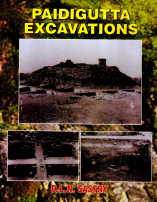 Paidigutta
Excavations : A Proto Historic Site in Lower Thungabhadra Valley Mehaboobnagar
District, Andhra Pradesh/D.L.N. Sastry.
Paidigutta
Excavations : A Proto Historic Site in Lower Thungabhadra Valley Mehaboobnagar
District, Andhra Pradesh/D.L.N. Sastry.
Contents: Foreword. Preface. 1. Introductory. 2. The site and its environs. 3. The physical and natural environment. 4. The cultural background. 5. Cultures and the main features. 6. Stratigraphy and structures. 7. Study of antiquities: a). Pottery. b). Stone tools. c). Neolithic stone blade industry. d). Metal and other objects. 8. Observations. Illustrations.
"The excavations at the Proto-Historic site. Paidigutta, were taken up to trace the cultural sequence belonging to the Neolithic-Chalcolithic, Megalithic and early historic periods and to find its relation with the one found in its middle reaches and the nearby sites just away from the confluence. Though early historic period data is not found at Paidigutta, that data is found at Chagaturu, a site developed as an independent site but few meters away from Paidigutta." (jacket)
[D.L.N. Sastry also wrote Pre-Historic Culture of the Manjra Valley.
No. 17311
